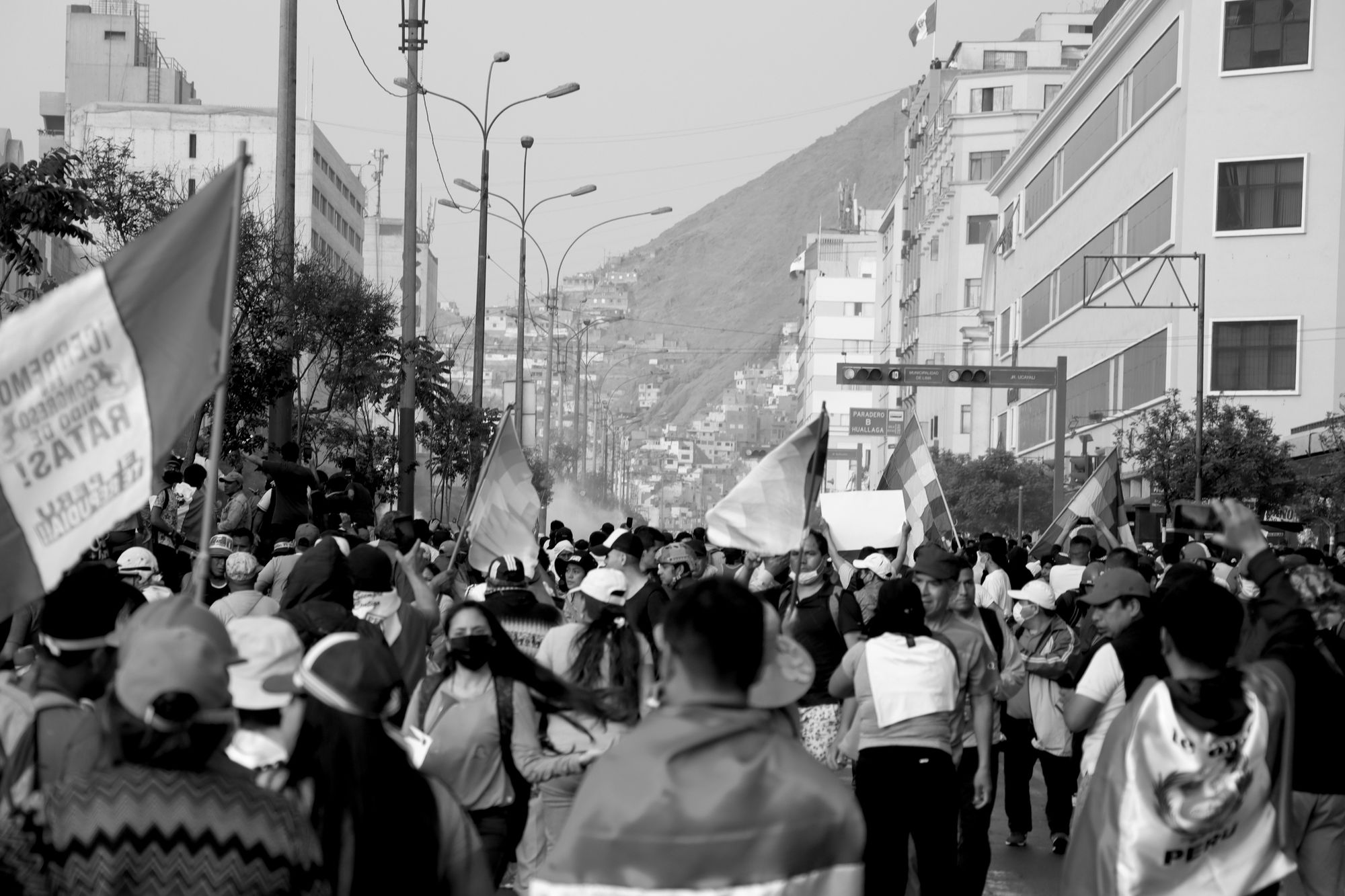Peru is in a state of political turmoil. The ex-president Pedro Castillo, who had been in power from July 28th 2021 until December 7th, 2022, will be remembered as the shortest dictator in the world after his unsuccessful Coup d’état that lasted two hours. In less than 10 minutes on air addressing the national audience, he dissolved the congress and called for a curfew. On that same day, only a few hours later, Congress impeached Castillo and Dina Boluarte, Castillo’s Vice-President. Currently, Castillo is under arrest for the next 18 months on charges of rebellion and conspiracy for the failed attempt of Coup d’état. These charges are in addition to the formal accusation by Peru’s Public Prosecutor's Office of leading a criminal organisation within his government.
The immediate response of Peruvians to Castillo’s arrest was to take to the streets and protest, especially in the South of the country, where many of his sympathizers are located and where the population is predominantly left-wing. Protests reached every region of the country, even mobilising people to the capital. When current President Dina Boluarte announced that the next elections were going to be held on April 2024, more people joined the protest. At first, protesters mostly wanted Pedro Castillo to be released, along with a new constitution and the closing of Congress; later, as a reaction to the death of nine demonstrators by the police in Ayacucho, a city located in the centre-south of Peru which was the epicentre of 1980s terrorism, protesters demanded justice and reparations for these victims. As the protests continued, the demands became linked to the provision of basic services and issues related to mining, environmental protection, etc.
Pro-status quo political forces such as those around Boluarte have been calling the protesters, ever since the beginning of the disorders, terrucos: but where does the term come from, and what are its implications? The action of calling protesters terrucos is known as terruqueo and derives etymologically, from the word terruco, which is a Quechua modification of the term terrorista (terrorist as a literal translation). This term was first used during the promulgation of the new Decree Law 25475 and 25659 (1992), which not only criminalised terrorism, but also so-called aggravated terrorism, acts of collaboration, illicit association, and defence of terrorism. This law was created in the context of the most violent and geographically extensive armed conflict in the history of Peru. The internal armed conflict fought by the government against Sendero Luminoso (a communist guerrilla armed group from Ayacucho, formed in the 1970s) and the Movimiento Revolucionario Tupac Amaru (a paramilitary armed group from the mid-1980s), caused 70,000 deaths and missing persons according to the Final Report of the Truth and Reconciliation Commission. The promulgation of the law made possible the persecution of those suspected of terrorist activities; however, it soon turned into a tool for the stigmatisation of the democratic political left, which was persecuted and even imprisoned.
The stigmatisation of the left as terrorist persists until this date, as it is a discourse constructed and used by the Peruvian political elite to protect the current economic model and to construct a social order where the people who are terruqueados are also enemies of the social and economic development. Therefore, the act of protesting is harshly attacked by the press and the government, because it disrupts the status quo, which however does not translate into development for the most vulnerable parts of the population. In that sense, terruqueo demonises those who hold progressive views and anyone who questions the current state of affairs.
To have a better grasp on this phenomenon, Carlos Meléndez explains how Peruvians can be categorised in groups according to their political preferences: a first group that is made up of the right and centre-right parliamentary benches, the security forces, big business(people), the traditional media and Lima's upper and middle classes; while the second is made up of the different left-wing groups, the rural population belonging to the lower socio-economic sectors and the heterogeneous world of informality. Social stratification creates a separation within society, loaded with a discriminatory undertone. The problem lies in the fact that the population that is stigmatised is predominantly peasant, non-white and from rural areas.
In the latest protest, the terruqueo phenomenon goes beyond stigmatization: it is rather an accusation and a justification for the use of violence by the police and armed forces to stop the population who is being manipulated by malignant forces, as the predominant narrative would have it. When referring to the protesters, Dina Boluarte speaks of criminal groups seeking to create chaos and attempting to undermine the rule of law. There are certainly different stages to consider for both the protesters and the government's reactions. At the beginning of the protests, in early December, the government decreed a state of emergency and sent the military into the streets in Apurímac, Ayacucho, Huancavelica, Cusco, and Junín - cities located in the centre and south Andes of Peru - alleging that the protests were being promoted by the Militarizado Partido Comunista (MPCP), a terrorist group linked with Sendero Luminoso. This information had been reported to Boluarte by the Joint Command of the Armed Forces and the Police as product of the intelligence work they have done in the VRAEM - a geopolitical region located between the cities of Ayacucho, Cusco, Junín and Huancavelica.
The extraordinary measures perpetrated by the government to remove constitutional freedoms from the citizens such as the freedom of movement, the freedom of assembly, and the personal freedom and security for 30 days during December, lead the protesters to (attempt to) take airports in five regions of Peru in order to prevent the Police forces from Lima to move through the country. In Ayacucho, the protesters approached the Coronel FAP Alfredo Mendívil Duarte Airport, where what some have named the massacre of Ayacucho took place. The Peruvian Armed Forces closed the airport in response. It was reported by Human Rights organisations that members of the Peruvian Army were seen shooting at civilians protesting. The hospital system in the city collapsed as the protesters suffered from gunshot wounds. According to the Ayacucho Regional Health Directorate, 8 people were killed and 52 were injured.
At the beginning of January, many protesters arrived in Lima from different regions of the country, mostly from rural areas. The government and the pro-establishment population believed that the protesters coming to Lima were obliged and funded by terrorist groups to assault the capital. The police response was to evacuate them using force. As justification the congressman Jorge Montoya, a member of the ultraconservative right party Renovación Popular, mentioned: “these are not acts of protest, but acts of terrorism; thus, they should be punished”. Therefore, the pro-establishment forces justified the use of violence as the government was fighting terrucos. According to the National Human Rights Coordinating Committee, most of the victims were shot in the chest, back, and head, indicating that the army fired indiscriminately at the demonstrators. In a public statement, the Joint Command of the Armed Forces stated that the army was attacked by "a mob with blunt objects, explosives, and handmade firearms", which activated "the legally established procedure, strictly applying the rules on the use of force". As time passed and the repression against civilians by the police and armed forces translated into more than 60 deaths, the protestors’ stance on Boluarte changed, demanding she resign and calling for immediate elections.
The idea behind the insinuation of terruqueo is to delegitimise movements that express their discontent with the government and the status quo. It is a tool being used since the 1990s that has a semantic and historic connotation that should shame anyone who uses it as it prevents Peruvians from finding reconciliation and development for all. People, especially those who come from rural areas, are stigmatised in order not to rebel. In this sense, it is still the most vulnerable population that suffers from this phenomenon, which has a very strong racist connotation. In the latest protests, it could be heard people refer to the protesters as if they were “others”, people who cannot make decisions on their own due to their social background, and insulting them by saying; “return to your chakra” evidencing that there is a discrimination towards farmers in rural areas, especially in the Andes. Even when confronted with facts on how the police and army are deliberately using force to contain the blockages of roads and people from gathering in squares, the other side of the Peruvian population justify it as a confrontation with terrucos. Therefore, terruqueo in this particular case legitimises the violence perpetuated by the government to invalidate what a large part of the Peruvian population has been clamouring for decades: change.

